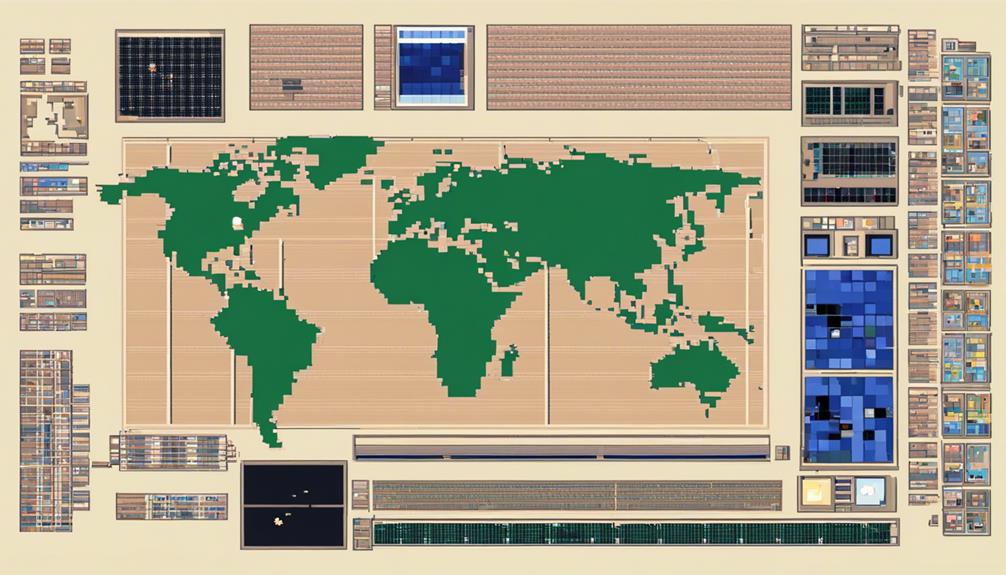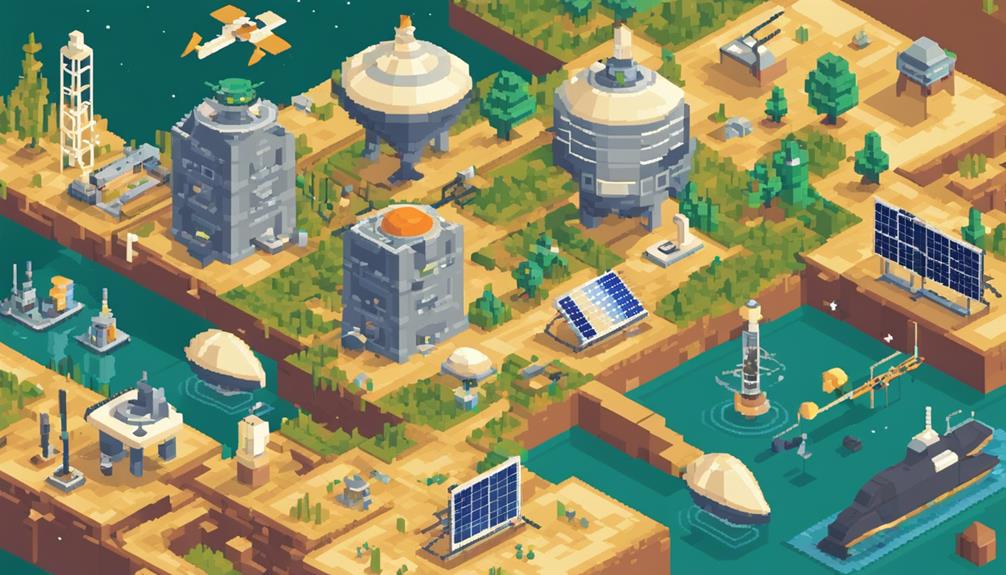As the space sector expands exponentially, the necessity of Environmental Impact Assessments (EIAs) for satellites becomes increasingly paramount. With the forecasted surge in revenue to surpass 1 trillion USD by 2040, the environmental ramifications of satellite operations cannot be overlooked. From tackling space debris to curbing energy consumption, the challenges ahead are intricate and demand meticulous evaluation. The future trajectory of EIAs for satellites holds the key to not only mitigating adverse environmental effects but also fostering sustainable practices that will shape the longevity of space exploration and satellite technologies.
Key Takeaways
- Implementing advanced monitoring technologies for real-time environmental impact assessment
- Integrating sustainable practices and technologies to enhance satellite environmental viability
- Developing long-term sustainability strategies for satellite operations
- Utilizing automation and AI for efficient and proactive environmental monitoring
Evolving Satellite Environmental Impact Assessments

In the realm of satellite technology, the evolution of environmental impact assessments is characterized by a focused analysis of resource utilization, atmospheric implications, and space debris management. Satellite environmental impact assessments delve into the environmental costs associated with satellite activities, including the atmospheric consequences of rocket launches. These assessments are essential for evaluating the global impacts of satellite technology, particularly in terms of air pollution and greenhouse gas emissions that result from launching satellites into orbit.
One critical aspect of evolving satellite environmental impact assessments is the management of space debris. As the number of satellites in orbit continues to increase, there is a growing concern about the risks of collisions and the generation of more space debris. Strategies for space debris management aim to mitigate these risks by implementing measures to track and avoid collisions, as well as promoting responsible space activities to minimize the creation of additional debris.
Furthermore, assessing the environmental impacts of satellites is crucial for making informed decisions regarding satellite constellation design and deployment. Understanding the trade-offs involved in satellite technology helps in optimizing the use of resources while minimizing negative environmental consequences. Collaborative efforts between public space agencies and commercial enterprises are underway to develop technologies and regulations that can effectively mitigate the environmental impacts of satellites on Earth's atmosphere.
Integration of Sustainable Practices
Considering the evolving landscape of satellite environmental impact assessments and the imperative focus on sustainability, the integration of sustainable practices in satellite technology has become a paramount concern for stakeholders across the industry. Sustainable practices within satellite technology encompass a range of initiatives aimed at reducing environmental impacts throughout the satellite's life cycle. One key aspect involves incorporating renewable energy sources into satellite operations, which not only enhances sustainability but also helps in reducing the carbon footprint associated with satellite activities. Moreover, implementing efficient satellite design strategies plays a crucial role in minimizing resource consumption and waste generation during both the manufacturing and operational phases of satellites.
In addition to these design and operational considerations, promoting responsible disposal practices for satellites is essential to mitigate long-term environmental risks and prevent the accumulation of space debris. Collaboration among stakeholders is also vital for the development and implementation of sustainable policies for satellite operations. By working together, industry players can share best practices, leverage expertise, and drive innovation in sustainable satellite technologies. Ultimately, the integration of sustainable practices in satellite operations is fundamental for ensuring the long-term environmental viability of satellite technology and its contributions to various sectors.
Advancements in Impact Monitoring Technology

The continual evolution of impact monitoring technology in satellite systems has revolutionized the precision and effectiveness of environmental assessments. Advanced satellite technology allows for real-time monitoring of environmental impacts with unparalleled accuracy. Satellite sensors, equipped with sophisticated capabilities, can detect even the most subtle changes in ecosystems and pollution levels, enabling early intervention and effective mitigation strategies.
The integration of data analytics and machine learning algorithms further enhances the precision of impact monitoring from satellite imagery. These technologies not only improve the accuracy of environmental impact assessments but also provide valuable insights for decision-making processes. By leveraging GIS integration, satellite data can be effectively combined with geographical information systems to create comprehensive maps of environmental changes. This integration facilitates a holistic understanding of the impact of human activities on ecosystems and natural resources.
Continuous advancements in satellite resolution and data processing capabilities continue to enhance the efficiency and effectiveness of environmental impact assessments. The ability to monitor, analyze, and map environmental changes through satellite technology plays a crucial role in sustainable management practices. By harnessing the power of satellite technology, environmental scientists and policymakers can make informed decisions to address pressing environmental challenges and promote sustainability.
Future Sustainability Strategies for Satellites
Advancements in impact monitoring technology have paved the way for future sustainability strategies for satellites, focusing on enhancing energy efficiency, implementing end-of-life disposal plans, and developing innovative materials for construction. The satellite industry is actively working towards a more sustainable future by incorporating various strategies:
- Energy Efficiency: Integrating solar panels into satellite design to harness renewable energy sources and reduce reliance on traditional power systems.
- End-of-Life Disposal: Establishing comprehensive plans for satellite disposal to prevent space debris accumulation and ensure responsible environmental practices.
- Global Standards: Collaborating with space agencies and industry stakeholders to set global standards for sustainable satellite design, operation, and end-of-life processes.
- Propulsion Systems: Optimizing propulsion systems to minimize environmental impact and enhance operational efficiency.
Enhancing Environmental Assessment Tools

Enhancing the efficiency of environmental assessment tools through advanced satellite technology is crucial for accurate monitoring and analysis of environmental impacts. Satellite technology plays a pivotal role in improving environmental impact assessments by providing high-resolution imaging and data analysis capabilities. Integrating machine learning algorithms further enhances the efficiency and accuracy of these assessments, allowing for more in-depth analysis of satellite data.
One key benefit of satellite-based tools is their ability to track changes in land use, deforestation, and urbanization, which are essential factors in assessing environmental impacts. Remote sensing satellites enable real-time monitoring of environmental changes, providing valuable data for proactive mitigation strategies. By utilizing Geographic Information Systems (GIS) alongside satellite data, comprehensive mapping and analysis of environmental changes can be conducted, aiding decision-makers in understanding the scope of environmental impacts.
Innovations in Impact Assessment Techniques
Innovations in impact assessment techniques for satellites encompass enhanced data collection methods, leveraging cutting-edge remote sensing technologies, and implementing automated monitoring systems. These advancements are revolutionizing the way satellite environmental impacts are evaluated, providing more comprehensive and real-time data for assessing ecological footprints and sustainability practices. By integrating these innovative techniques, satellite operators can make informed decisions to mitigate environmental consequences and enhance the overall sustainability of their operations.
Enhanced Data Collection
How can advanced remote sensing capabilities revolutionize the way environmental impacts are assessed for satellites? Enhanced data collection techniques leverage satellite imagery with higher resolution and spectral sensitivity to provide detailed insights. Innovations in enhanced sensors and data processing algorithms enable improved identification and monitoring of environmental impacts. Real-time monitoring facilitated by cutting-edge technology allows for timely analysis of changes in environmental parameters. These advancements in data collection techniques contribute significantly to more accurate assessments of satellite-related environmental impacts.
Remote Sensing Technology
Building on the advancements in enhanced data collection techniques, the utilization of remote sensing technology revolutionizes impact assessment techniques by providing detailed analysis of environmental changes through satellite imagery. Remote sensing technology enables monitoring of pollution sources, ecosystem changes, and spatial analysis for environmental impact assessments. By processing satellite data with advanced algorithms, it facilitates the identification of deforestation, urbanization patterns, and water quality variations. This technology offers real-time data, enhancing the accuracy and efficiency of impact assessments. Through the continuous monitoring of land use, vegetation cover, and other environmental parameters, remote sensing contributes to a comprehensive understanding of the impact of human activities on ecosystems.
Automated Monitoring Systems
Utilizing advanced AI and machine learning algorithms, automated monitoring systems play a pivotal role in enhancing the efficiency and accuracy of environmental impact assessments for satellite operations. These systems process large volumes of satellite data to detect changes in environmental parameters, providing real-time insights into the impacts of satellite activities. Through the integration of satellite imagery, sensor data, and modeling tools, automated systems enable comprehensive analysis for effective impact assessment. By enhancing the speed, accuracy, and scalability of assessments, these innovations facilitate proactive mitigation strategies, ensuring sustainable satellite operations.
- Automated monitoring systems utilize AI and machine learning for efficient data analysis in environmental impact assessments.
- These systems can process large volumes of satellite data to detect changes in environmental parameters and assess impacts accurately.
- They provide real-time insights into the environmental effects of satellite operations.
- Innovations include comprehensive analysis and proactive mitigation strategies for satellite activities.
Ensuring Long-term Satellite Sustainability
Ensuring long-term satellite sustainability necessitates addressing key factors such as satellite lifespan extension, the development of sustainable propulsion systems, and effective debris mitigation strategies. These components are crucial for maintaining satellite functionality, reducing environmental impact, and promoting overall sustainability in space operations. Implementing innovative solutions in these areas will be paramount for the long-term viability of satellite missions.
Satellite Lifespan Extension
To enhance satellite sustainability and mitigate environmental impact, the extension of satellite lifespans through strategic maintenance and innovative technologies is imperative. Extending satellite lifespan reduces environmental impact by decreasing the frequency of satellite replacements. Sustainable practices like efficient fuel management and onboard systems maintenance contribute to satellite longevity. Satellite lifespan extension strategies aim to minimize space debris generation and resource consumption. Implementing innovative technologies for satellite health monitoring and maintenance enhances lifespan extension efforts. Prolonging satellite missions through effective management supports long-term environmental sustainability goals.
Sustainable Propulsion Systems
Sustainable propulsion systems play a pivotal role in enhancing the long-term sustainability of satellites by reducing emissions and minimizing space debris generation. Electric propulsion technologies, such as ion thrusters, offer fuel efficiency and longer operational lifetimes, contributing to satellite sustainability. Innovative alternatives like solar sails and plasma thrusters provide environmentally friendly propulsion options. The use of green propellants, such as water or xenon, helps in minimizing the environmental impact in space, aligning with the goals of sustainable satellite operations. Implementing these sustainable propulsion systems is crucial not only for reducing emissions but also for lowering space mission costs in the long run, making them an integral part of future satellite missions.
Debris Mitigation Strategies
Debris mitigation strategies are essential components in the quest for long-term satellite sustainability through the reduction of collision risks and the mitigation of space debris fields. Effective measures are crucial for space safety and risk management. Key points to consider include:
- Developing active debris removal technologies to address the increasing amount of space debris.
- Adhering to international guidelines and regulations to promote responsible space activities and manage space debris.
- Implementing de-orbiting strategies for satellites at the end of their operational lifetimes to prevent long-lasting space debris.
- Ensuring that debris mitigation measures are in place to minimize risks to operational satellites and sustain satellite sustainability.
Addressing Environmental Challenges in Space
Addressing the environmental challenges in space necessitates a comprehensive approach to mitigating the impacts of satellite technology on Earth's atmosphere and resources. Satellites in Low Earth orbit have brought about potential environmental issues such as increased light pollution and the atmospheric consequences of rocket launches and satellite operations. The growing number of satellites increases the risk of collisions, creating space debris that poses threats to active satellites. Effective space debris management strategies, including de-orbiting satellites at the end of their operational lifetimes, are crucial for reducing environmental risks and ensuring sustainable development in space activities.
Rocket launches play a significant role in contributing to air pollution and greenhouse gas emissions, underscoring the importance of adopting sustainable practices in satellite technology. Balancing the benefits of satellite technology with its environmental impacts requires careful evaluation of trade-offs and the optimization of satellite systems for long-term sustainability. Environmental monitoring is essential to assess the impact of satellite activities on climate change and other environmental factors, guiding the implementation of measures to address these challenges effectively. By addressing these environmental challenges proactively, the space industry can work towards a more sustainable and responsible approach to satellite operations.
Sustainable Practices in Satellite Operations

Efficiency in satellite operations is paramount for minimizing environmental impacts across the satellite's life cycle. Satellite operators are increasingly focusing on sustainable practices to address environmental challenges in space. By implementing energy-efficient technologies, operators can lower energy consumption and reduce the carbon footprint of satellite operations. Moreover, proper disposal and de-orbiting strategies are crucial for minimizing space debris and ensuring long-term sustainability in space activities.
To further enhance sustainability, satellite operators are exploring the adoption of renewable energy sources for satellite power. This shift towards renewable energy not only reduces the environmental impact but also contributes to broader environmental conservation efforts. Additionally, integrating circular economy principles in satellite design and manufacturing processes can promote resource efficiency and waste reduction, aligning with the sustainability goals of the industry.
Frequently Asked Questions
What Is the Future of Satellite Technology?
The future of satellite technology is characterized by continuous advancements in satellite capabilities, including enhanced satellite navigation, improved satellite communication, and increased data transmission rates. Innovations in satellite design are enabling more efficient climate monitoring, while sustainable practices are being integrated to address concerns such as space debris and environmental impact. Satellite technology is evolving towards greener solutions, leveraging solar energy and green technology to ensure long-term sustainability in satellite operations.
What Environmental Impacts Have Been Connected to the Use of Satellites?
Satellite technology has been linked to environmental impacts such as wildlife disruption, light pollution, space debris, air pollution, and energy consumption. Radio frequency interference can disrupt ecosystems, while satellite collisions create space debris endangering other satellites. Mitigation strategies are essential, including de-orbiting satellites to prevent space debris buildup. Addressing these impacts is crucial for sustainable satellite operations and minimizing their environmental footprint.
How Are Satellites Used in Environmental Monitoring?
Satellites are crucial for environmental monitoring due to their ability to provide highly accurate data through remote sensing. They play a vital role in tasks such as vegetation mapping, ocean monitoring, climate change analysis, deforestation tracking, urban sprawl assessment, and wildlife conservation efforts. The data collected by satellites aids in comprehensive environmental analysis, enabling effective decision-making and conservation strategies. Their widespread applications make satellites indispensable tools in modern environmental monitoring efforts.
How Do Satellites Affect the World on an Environmental Scale?
Satellites have a significant environmental impact, contributing to resource depletion, ecosystem disruption, waste management challenges, energy consumption, carbon emissions, biodiversity loss, pollution control needs, and climate change. Their presence affects the world on a large scale, necessitating a balance between technological advancements and environmental preservation. Strategies for mitigating these impacts are critical in achieving sustainable satellite operations and minimizing their adverse effects on the environment.

